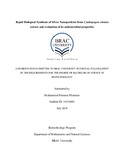| dc.contributor.advisor | Khan, Kashmery | |
| dc.contributor.author | Muntasir, Mohammed Nimeree | |
| dc.date.accessioned | 2019-01-02T05:58:22Z | |
| dc.date.available | 2019-01-02T05:58:22Z | |
| dc.date.copyright | 2018 | |
| dc.date.issued | 2018-07 | |
| dc.identifier.other | ID 14336002 | |
| dc.identifier.uri | http://hdl.handle.net/10361/11066 | |
| dc.description | This thesis is submitted in partial fulfilment of the requirements for the degree of Bachelor of Science in Biotechnology, 2018. | en_US |
| dc.description | Cataloged from PDF version of thesis. | |
| dc.description | Includes bibliographical references (page 35-38). | |
| dc.description.abstract | It has been well known for many years that silver Nanoparticles (NPs) are toxic to microorganism and can potentially kill them. They can also provide solution to different technological and environmental problems such as energy conversation, tailor-made medicine, cancer treatment, waste water treatment etc. Nanoparticles can be synthesized in many different ways such as physical and various other chemical methods. These methods are expensive and use many different toxic substances which make them difficult to scale these methods for mass production. In recent years it has been found that plant molecules can perform the same reduction reactions necessary for the production of nanoparticles but in a much more efficient way. Here, green chemistry were employed for the synthesis of silver nanoparticles (AgNPs) using leaf extracts of Cymbopogon citratus (Lemon Grass). Effects of different parameters such as temperature, pH and volume of plant extract were also tested using their absorbance pattern at different wavelengths. The total formation of the AgNPs was observed visually with a color change from yellow to brownish-black. UV-visible spectroscopy was used to monitor the quantitative formation of silver nanoparticles which showed a signature peak in absorbance between 400 and 500 nm. Changing different parameters had a significant effect on the size and position of the peak which also made an impact on the pattern of the curve, signifying the formation of nanoparticles of various shapes and sizes. The nanoparticles showed enhanced antibacterial activity against selected bacterial strains which analyzed based on the zone of inhibition (ZOI) and minimal inhibitory concentration (MIC). | en_US |
| dc.description.statementofresponsibility | Mohammed Nimeree Muntasir | |
| dc.format.extent | 38 pages | |
| dc.language.iso | en | en_US |
| dc.publisher | BRAC University | en_US |
| dc.rights | BRAC University theses are protected by copyright. They may be viewed from this source for any purpose, but reproduction or distribution in any format is prohibited without written permission. | |
| dc.subject | Cymbopogon citratus | en_US |
| dc.subject | Lemon grass | en_US |
| dc.subject | Antimicrobial property | en_US |
| dc.subject | Energy conversation | en_US |
| dc.subject | Cancer treatment | en_US |
| dc.subject.lcsh | Biological Phenomena. | |
| dc.subject.lcsh | Nanoparticles. | |
| dc.title | Rapid biological synthesis of silver nanoparticles from Cymbopogon citratus extract and evaluation of its antimicrobial properties | en_US |
| dc.type | Thesis | en_US |
| dc.contributor.department | Department of Mathematics and Natural Sciences, BRAC University | |
| dc.description.degree | B. Biotechnology
| |

